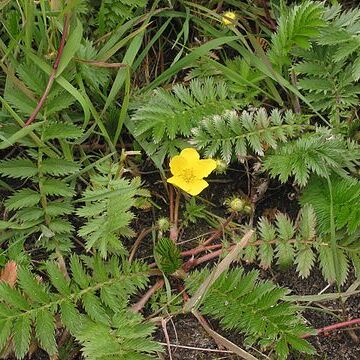Perennial, at first acaulescent, with tufted basal lvs, soon emitting long stolons that root and produce similar but smaller clusters of lvs at the nodes; lvs oblanceolate, to 3 dm, pinnately compound with numerous lfls often alternating with other much smaller ones; lfls oblanceolate or narrowly elliptic, to 4 cm, increasing in size distally, sharply toothed, tomentose beneath and also silvery-sericeous with long appressed hairs, glabrous to sericeous above; stolons, pedicels and leaf-axes generally villous, the hairs often spreading; fls yellow, 1.5–2.5 cm wide, solitary on slender pedicels from the nodes of the stolons and sometimes from the original plant; bractlets often toothed; style lateral; achenes 2.5 mm, about as thick, deeply furrowed on the summit and back; 2n=28, 35, 42. Moist or wet, open places; circumboreal, s. to N.Y., n. Ind., Io., and N.M. May–Sept. (Argentina anserina)
Basal leaves: petiole (0.5–)1–15(–25) cm, long hairs absent or sparse to dense, 1.5–3.5 mm; larger leaflets (0.4–)0.5–5(–7) × (0.2–)0.3–2(–3) cm, surfaces: abaxial with long hairs absent or sparse to abundant, not restricted to veins, 0.5–2(–2.5) mm, cottony-crisped hairs usually dense or usually absent (in subsp. groenlandica), adaxial with long hairs absent or sparse to abundant, cottony-crisped hairs usually absent, sometimes sparse to common (especially subsp. yukonensis). Flowers: epicalyx bractlets narrowly to broadly ovate-triangular or linear to elliptic, (2–)2.5–7(–8) × (0.3–)0.5–3(–3.5) mm, often 2-fid or dentate; sepals (3–)3.5–7(–9) mm, apex subacute to acuminate; petals (4–)5–15(–20) × (2.5–)3–10(–12) mm; filaments (1–)2.5–3.5(–4.5) mm, anthers 0.7–1.3 mm; carpels (10–)20–200(–250). Achenes 2 mm.
A herb. It keeps growing from year to year. It grows 30 cm tall. The roots are prolonged downwards. It can have root tubers. The leaves near the root have 6-11 pairs of leaflets. The leaves on the stem have fewer leaflets. The flowers occur singly in the axils of leaves. The petals are yellow.

